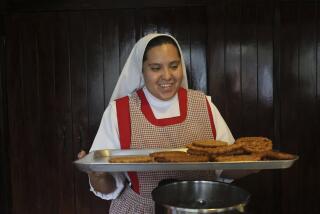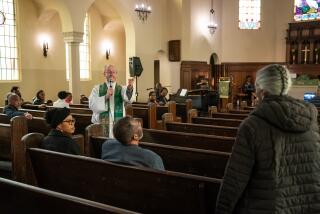Vow of Poverty Trumps Bequest
- Share via
ST. MEINRAD, Ind. — They still tool around these gently rolling green hills in the same sturdy Chevys. They still wear their same black robes. Their rooms are spartan as ever and still called cells.
And the soothing Gregorian chants echo deep from these sandstone walls -- just as they have for 150 years.
For the monks of St. Meinrad Archabbey, life follows immutable rhythms: Bells peal crisply from Romanesque towers, noontime prayers are read from white oak choir stalls, breakfast and dinner are eaten in silence.
Not much can change this brotherhood of holy men who have taken a vow of poverty. Not war, not peace, and certainly not money.
Not even a gift of nearly $27 million.
*
At St. Meinrad’s, there are many rules and one inescapable reality: Monks live by needs, not wants. Money is not coveted, not even considered in many everyday decisions.
So when Father Lambert Reilly, leader of the archabbey, recently announced that two longtime benefactors -- both elderly women -- had willed St. Meinrad’s nearly $27 million, the monks were grateful and surprised, but not inclined to celebrate.
“We’re guys, first of all,” Father Tobias Colgan, St. Meinrad’s prior said with a laugh. “And we’re guys who are monks ... we lean more toward the introverted.”
The exception is Reilly, 71, who blends a wry wit (one of his talks is titled “To Live Is to Annoy”) with a gift for gab. It has fallen to him to explain to outsiders two facts: The monks don’t get the millions and, behind these walls, a lottery-sized windfall is not a temptation. Not even for a minute.
“I still will wear my black wash pants,” Reilly said, showing off his modest wardrobe of half a dozen or so pairs of indistinguishable pants, jackets and robes. “In the airport, I’m not going to buy a newspaper -- I’ll pick up one from an empty seat. It doesn’t change my life.
“As St. Paul said, you have it or you don’t have it, and you learn to live with it either way.”
For 150 years, the men of St. Meinrad have chosen to live without.
The Benedictine monastery is a one-for-all society where everything is shared, from the box of chocolates that Reilly received as a gift to the television that the monks watch together in the recreation room. (TVs in individual rooms are taboo.)
Even spare clothes sent by family and friends are pooled in a “rags rack” that are anyone’s for the taking.
And virtually every need or request, whether it’s a new pair of shoes or using one of the fleet of Chevys for an excursion, must be approved by the prior -- St. Meinrad’s No. 2 man, who acts as a business manager.
If this kind of environment seems stifling, the monks say it’s just the opposite.
“There are so many things other people have to worry about and I don’t -- job security, paying the bills, how to support the family,” said Father Mark O’Keefe, president-rector of the school of theology. “And style? I certainly don’t have to worry about style.
“It’s very freeing,” he added. “That’s how it should be. Monks need to have a freedom to be contemplative.”
The monks pray together three times a day -- novices have the bracing 5:30 a.m. bell-ringing duty -- and attend morning Mass in a century-old church where sunlight streams in through German-crafted stained-glass windows.
But monks do not live by faith and prayer alone.
St. Meinrad feeds and clothes 114 monks (their black habits are sewn here), and runs a seminary with 82 priests-in-training and a theology school with 100 students. The archabbey also grapples with routine bills: insurance, utilities and other costs of running a 250-acre monastery.
The monks range in age from 21 to 103, and most work here as tailors, carpenters, cooks, landscapers, composers, writers and teachers. Several have studied in Europe and one is fluent in 16 languages. Others live and have jobs outside the monastery.
St. Meinrad also owns and operates two businesses: the Abbey Press, which sells books, cards and religious items through a mail-order company and employs more than 300 people, and a casket-making factory in a nearby town.
Last fall, St. Meinrad’s announced a five-year project to raise $40 million to secure the archabbey’s future and, O’Keefe says, the huge bequest surely “will take some pressure off us.”
When the gift was announced this spring, pleas for help soon followed from near and far. Reilly heard from one monastery in Vietnam needing money to add a wing and another in Iowa planning to build an infirmary.
This money, however, will be used for St. Meinrad. Some will go for scholarships, and it also will help raise teacher salaries, renovate dormitories for the seminarians and make other improvements, including a new $5.2-million retreat center.
It was the center that was the inspiration for St. Meinrad’s gift.
Two wealthy women -- Virginia Basso and Bernice Davey -- were regulars here for decades, making the trip from their homes in Indianapolis. They grew attached to the monastery and the monks who call it home.
Both were widowed and childless, and, Reilly says, “we became their family.” When the women became too sick to make the trip, the monks visited them.
Reilly says the monastery knew that both women had included St. Meinrad in their wills, but he was stunned by the size of the bequest -- each left more than $13 million.
Although the women were friends and often visited the monastery together, they were very different personalities.
Basso, who died last summer at 91, was an opera and symphony devotee who enjoyed reminiscing about her days in Italy, France and England when her husband, Raymond, worked in Europe for Eli Lilly & Co. She could hold forth with ease on any topic from art to the stock market.
“Virginia was sophisticated but she wasn’t stuffy,” Reilly said. “She was fun. She had bright, flashing eyes. She was a vibrant person
Basso also was deeply religious, the archabbot says, and she and her husband dreamed of having a son who would become a priest.
Now some of her money will be used to train priests.
Davey, who died in January at 90, first visited the retreat in the early 1970s with her husband, William, who was in the insurance business. She was a listener more than a talker. Always perfectly coifed, she often spent Holy Week at St. Meinrad’s, as well her birthday.
“Bernice was one who become a mother to the younger monks,” Reilly said.
They were among more than 10,000 visitors from throughout the nation who make the pilgrimage each year to this tranquil corner of southeastern Indiana, where there are lush canopies of oak and holly trees, a garden waterfall and buildings made from hand-chiseled sandstone, the rock mined from a quarry on the grounds.
The serenity appeals to the monks too, of course.
O’Keefe, 47, the rector, recalls the day he arrived by bus 25 years ago, sight unseen, from his home in Savannah, Ga.
“I thought, ‘Oh, my God ... it can’t be way out here,’ ” he recalled. “But from that point in the road where I saw the abbey on the hill -- at that moment, there was just a profound sense of peace, just as I imagined love at first sight must be. I thought, this is right. This works.”
Thousands of men have settled in this monastery since it was founded by two monks who journeyed from Einsiedeln Abbey in Switzerland in 1854. They came to help a local priest meet the pastoral needs of the expanding German-speaking Roman Catholic population.
The archabbey is named after St. Meinrad, a 9th century monk known as the “martyr of hospitality,” after he was killed by two visitors he had invited in for food and lodging.
The monastery is still known for its hospitality, delivered by four generations of men, most of whom also are ordained priests.
The senior monk is silver-haired, freckle-faced Theodore Heck, a priest who has devoted more than 80 of his 103 years to St. Meinrad, including a 57-year teaching career.
“I am retired now -- and tired,” he quipped, although he still occasionally helps out in the office.
The junior man of St. Meinrad is Timothy Bauscher, a novice who, at age 21, is a fan of Harry Potter, “The Lord of the Rings” and techno-music, and a whiz with a computer.
Pop culture aside, Bauscher says St. Meinrad is where he belongs -- although like anyone his age, he gently grumbles about waking up at 4:30 a.m. to prepare for bell-ringing duty.
“For me, this feels less secluded than the life I used to lead,” said Bauscher, who previously worked as a computer programmer. “There’s no withdrawing, no day off. This is a much more active life.”
“This world is more real to me,” he added. “It’s like the colors are more true.... A walk outside seems to give me more energy. A volleyball game is more fun. Everything is improved.”
St. Meinrad’s future depends on recruiting other young men who reject material riches. About half the novices who come here decide that it’s not for them.
“I think the world and society and all that offers a lot more allurements these days,” O’Keefe said. “It makes our way of life even more important.”
And he says he thinks that the two benefactors appreciated that.
“They knew [that] by giving to men who have taken a vow of poverty, it would not be used for selfish purposes,” O’Keefe said.
And, he says, they also probably saw the incongruity of leaving a fortune to monks.
“It’s ironic, isn’t it?” he said. “In that sense, it’s kind of comical. At the same time, I don’t think that irony was lost on these ladies.”


